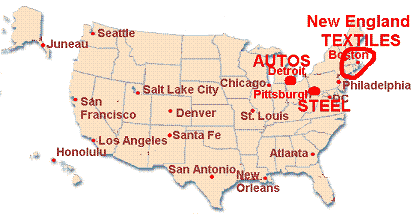|
STUDY GUIDE USII.2b
Geography Themes
Transportation Links Resources, Products, and Markets |
The student will
use maps, globes, photographs, pictures, and tables for
b) explaining relationships among natural resources, transportation, and
industrial development after 1877. |
|
How did advances in
transportation link resources, products, and markets? |
Advances in transportation linked resources, products, and markets:
• Transportation of resources |
Railroads
were key- Railroads could reach interior areas, including places where an
inadequate water supply or rough terrain made canals impossible. By 1860, a
network of thirty thousand miles linked most of the nation's major cities
and towns. |
|
• Moving natural resources (e.g., copper and lead) to eastern factories |
Natural resources were moved by rail to
manufacturing centers in the east. Copper and lead, mined in New
Mexico, Arizona, and Utah was shipped by rail to eastern factories. |
|
• Moving iron ore deposits to sites of steel mills (e.g., Pittsburgh) |
In the mid-1800s, huge, easily mined deposits
of high-grade iron ore were discovered in Michigan, Minnesota, and
Wisconsin. The iron ore was shipped by
rail to Pittsburgh, which by 1860 became the center for the emerging
new steel industry. The need for armaments in the Civil War gave a great
boost to the city’s iron and steel industry.
The new Bessemer process allowed iron and coal to be converted cheaply into
steel, which was manufactured into a variety of products - from nails to
rails. |
|
• Transporting finished products to national markets |
Manufactured goods moved by railroad from
eastern factories to markets around the U.S. |
|
What are some examples of manufacturing areas that were
located near centers of population? |
Factories needed workers, so
they were built where people lived. The factories attracted more workers and
cities grew around them.
 Examples of manufacturing areas clustered near centers of
population. Examples of manufacturing areas clustered near centers of
population.
• Textile industry—New England
• Automobile industry—Detroit
• Steel industry—Pittsburgh
|
 Examples of manufacturing areas clustered near centers of
population.
Examples of manufacturing areas clustered near centers of
population.